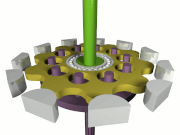A cycloidal drive or cycloidal quickness reducer is a mechanism for reducing the quickness of 
The input shaft drives an eccentric bearing that in turn drives the cycloidal disc within an eccentric, cycloidal movement. The perimeter of the disc is targeted at a stationary ring equipment and has a series of output shaft pins or rollers placed through the planetary gearbox facial skin of the disc. These result shaft pins straight drive the output shaft as the cycloidal disc rotates. The radial motion of the disc isn’t translated to the result shaft.